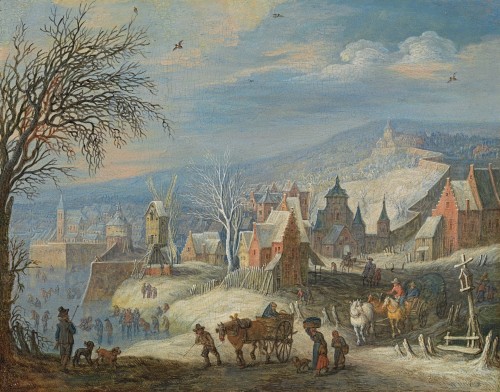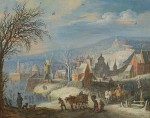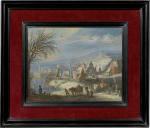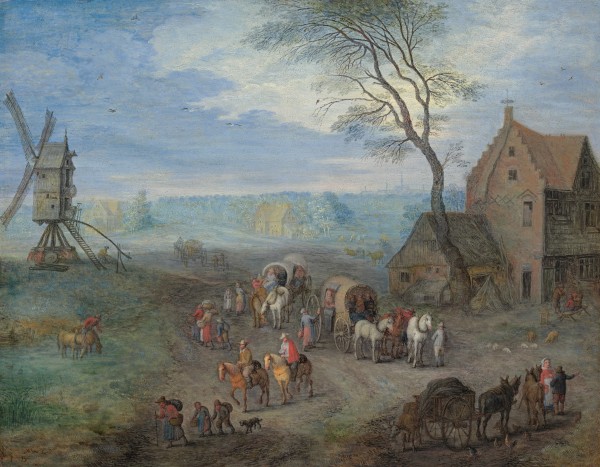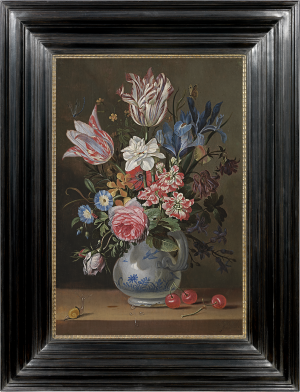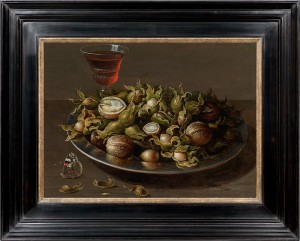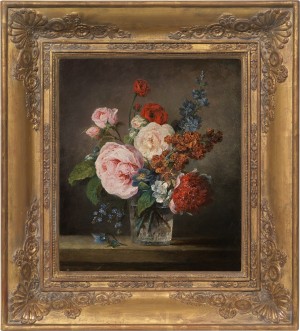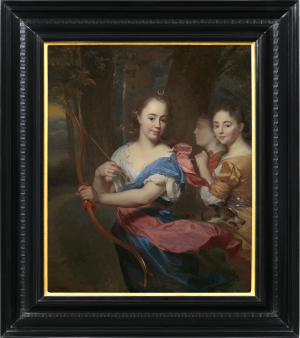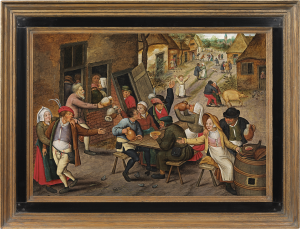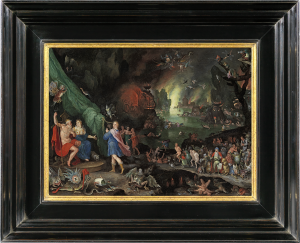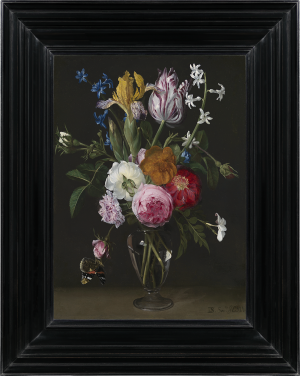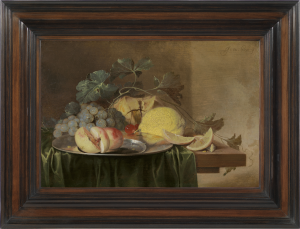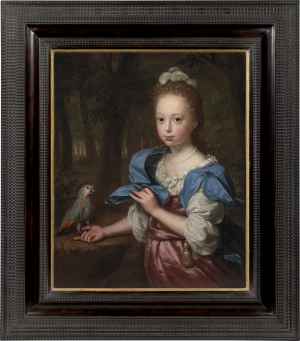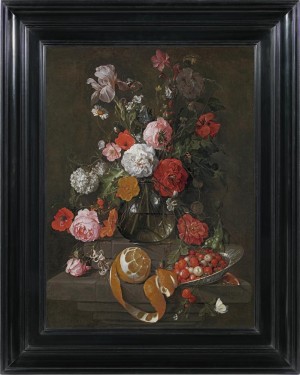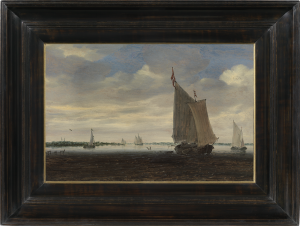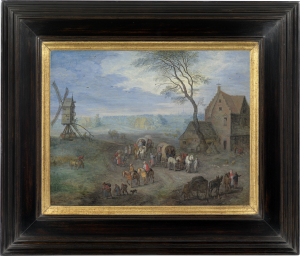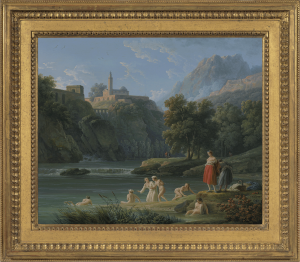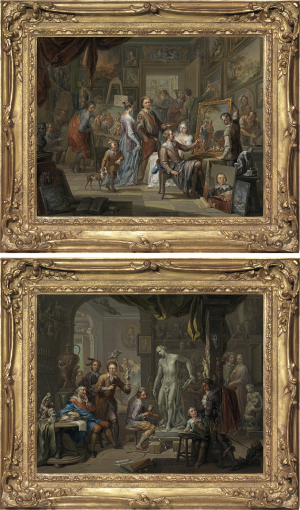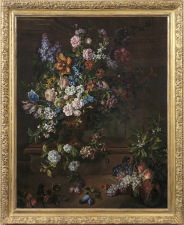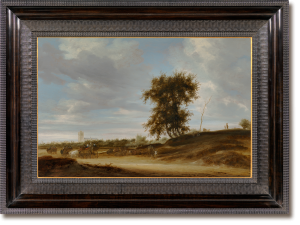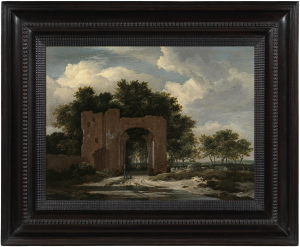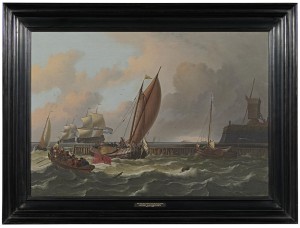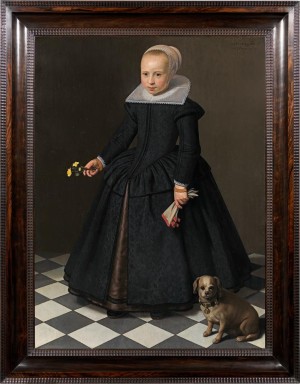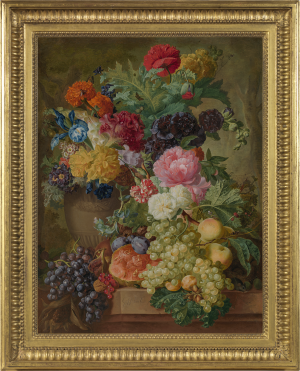Josef van Bredael
A winter landscape with a cart and a waggon, a hunter and his dogs and figures skating below a town
Oil on copper: 6 x 7.8 (in) / 15.2 x 19.7 (cm)
Signed with initials lower right: iB
This artwork is for sale.
Please contact us on: +44 (0)20 7493 3939.
Email us
JOSEF VAN BREDAEL
Antwerp 1688 - 1739 Paris
Ref: BZ 199
A winter landscape with a cart and a waggon, a hunter and his dogs and figures skating below a town
Signed with initials lower right: iB
Oil on copper: 6 x 7 ¾ in / 15.2 x 19.7 cm
Frame size: 10 ¾ x 12 ¾ in / 27.3 x 32.4 cm
Painted circa 1710
Provenance:
Private collection, UK, acquired by circa 1930;
by descent
Joseph van Bredael came from a large family of Antwerp artists and specialized in compositions inspired by the work of Jan Brueghel the Elder (1568-1625), second son of the famed Pieter Bruegel the Elder (c.1525-1569). Known as ‘Velvet Brueghel’ for the miniaturist delicacy of his work, Jan was hugely successful in his own lifetime. For the next two centuries, his paintings were avidly collected and a number of artists emulated his style, among them Joseph van Bredael, his cousin Jan Frans van Bredael the Elder (1683-1750), Matthijs Schoevaerdts (1665-after 1703) and Théobald Michau (1676-1765).
Joseph van Bredael spent four years from 1705 copying and creating landscapes in the manner of Jan Brueghel, working for the Antwerp art dealer J de Witte. He built his career upon an ability to reimagine Jan’s seventeenth century world, tuned to the sensibility of his own day. This painting is on copper, a support often used by Brueghel for his more important cabinet works, as it is more expensive than the commonly used wood panel. It provides a particularly smooth surface, suited to the miniaturist approach of both Brueghel and van Bredael’s style. Although small in compass, these landscapes have a panoramic sweep and were meant to be examined in detail, perhaps taken off the wall and held in the hand, delighting the eye with their complexity.
A village scene with travellers by a windmill is closely based on a Winter landscape with skaters by Jan Brueghel the Elder and Joos de Momper the Younger (Gemäldegalerie Alte Meister, Schloss Wilhelmshöhe, Kassel). The complex composition, with the star-shaped fortifications and walled town giving onto rolling, snowy landscape, is particularly appealing. Van Bredael’s early eighteenth century style is softer and his palette lighter than Jan Brueghel’s. Van Bredael draws upon the fascination with winter and its pleasures which had inspired artists for over a hundred years, from the pioneering winter scenes of the Dutch painter Hendrick Avercamp (1585-1634), made in the first decade of the seventeenth century. Townsfolk hurry to skate on the frozen river beneath the fortifications, while villagers make their way home from market in a cart and a waggon, passing a wayside shrine set there to protect them as they set out into the countryside. A hunter and his dogs watch the scene, silhouetted against the ice. To Bredael’s eighteenth century audience, this world of windmills and round towers, churches and step-gabled houses represented a tranquil, timeless society and a reminder of the Old Master tradition of European landscape painting.
Van Bredael made four other versions of this composition, all with variations in the details, two on copper and two on panel[1].
Jan Brueghel the Elder and Joos de Momper the Younger, Winter landscape with skaters.
Gemäldegalerie Alte Meister, Schloss Wilhelmshöhe, Kassel.
JOSEPH VAN BREDAEL
Antwerp 1688 – 1739 Paris
Joseph van Bredael was born on 18th August 1688. He came from a large family of Antwerp artists whose work was in demand from as far afield as London, Paris and Vienna. He was the grandson of Peeter van Bredael (1629-1719) who specialised in Italian pastoral landscapes, and the second son of the battle painter Georges van Bredael (161-1705). Joseph’s mother Johanna was the daughter of the artist Abraham van Diepenbeeck. Joseph’s elder brother Jean-Pierre Bredael the Younger also specialized in battle scenes, while his cousin Jan Frans van Bredael the Elder (1683-1750) painted landscapes.
On 27th July 1705 Joseph van Bredael was employed for four years by the Antwerp art dealer J de Witte to copy small cabinet paintings by Jan Brueghel the Elder (1568-1625) and Philips Wouwerman (1619-1668). Much of Joseph’s work consists of variants upon themes treated by Jan Brueghel, painted in a soft and delicate miniaturist style with a slightly warmer palette than Jan’s. Joseph van Bredael signs his paintings jB, which to the unwary, in his own day and later, could suggest the hand of Jan Brueghel the Elder.
Joseph is thought to have made a visit to Paris in 1725. He made copies after Claude Lorrain for the diplomat and collector Jean-François Leriget de la Faye (1674-1731). In 1735 Joseph received a legacy from his brother Jean-Pierre, who had died in Vienna. Joseph emigrated to Paris and became a member of the Académie Royale. He became a Court painter to Louis, Duc d’Orléans (1703-1752), cousin of Louis XV and died in Paris in 1739.
[1] See Klaus Ertz and Christa Nitze-Ertz, Josef van Bredael 1688-1739: Die Gemälde mit Kritischem Oeuvrekatalog, Lingen 2006, p.153, cats. E27, E28 and E29. Another version on copper, unsigned, was sold at Christie’s London on 4th December 2013, lot 139.

